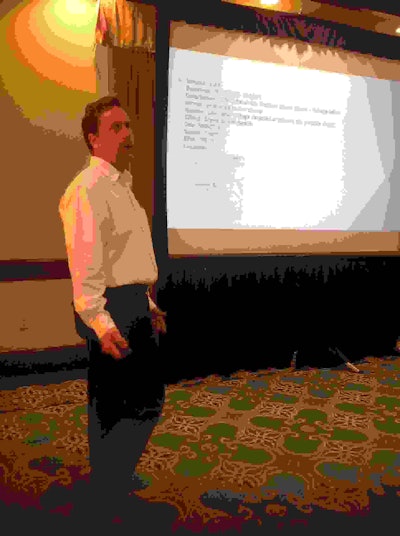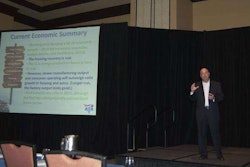 Mesilla Valley Transport’s Mike Kelly gave a seminar session Tuesday, May 21, discussing business intelligence for fleets at the 2013 CCJ Spring Symposium in Birmingham, Ala.
Mesilla Valley Transport’s Mike Kelly gave a seminar session Tuesday, May 21, discussing business intelligence for fleets at the 2013 CCJ Spring Symposium in Birmingham, Ala.Nine years ago, Mike Kelley unleashed a hungry beast at Mesilla Valley Transportation. When executives and managers began to receive new reports through its new business intelligence platform from Microsoft, they began asking for more.
“As we started producing some reports the report request volume tripled. And it just keeps going,” says Kelley, director of information technology for the Las Cruces, N.M.-based carrier with 1,200 trucks. “As you get involved, the hunger for data that starts to surface is going to be huge.”
Kelley spoke during a technology breakout session on “modernizing your fleet with business intelligence” at the CCJ Spring Symposium in Birmingham, Ala., on May 21-22. The goal for using BI, he says, is to be able to quickly assemble information from multiple locations and systems to determine the status and to take action.
MVT has real-time, dashboard-style reports accessible through its Microsoft Sharepoint webpage as well as through daily, scheduled emails. The reports show a variety of KPIs, both on a macro and individual level. Fleet managers, for example, have individual dashboards that show the tasks that need to be cleared from their queue like out-of-route drivers, unassigned drivers and projected late loads.
MVT also uses the Microsoft BI platform to create dashboards for its incentive plans for drivers, managers and departments. Everyone in the organization now has a scorecard that they are being measured against.
The value of BI goes beyond creating reports. MVT has modernized its fleet by using its BI platform to turn information into workflows, Kelley says. Examples of the workflows it has created include:
Fault codes. Engine fault code information is captured through the PerformX feature of PeopleNet’s onboard computing and mobile communications platform. Using its Microsoft Sharepoint system, fault codes are reparsed into a “human readable” form the shop uses to instantly know what is happening and how to respond.
Inspections. MVT uses the Ventech system to capture tire pressure and tread depth as vehicles drive over sensor plates installed at the front gate of its facilities. Using the truck number captured by Ventech, MVT created a workflow that checks the driver’s safety qualifications, such as missing logs, before they reach the next check point.
Accessorials. A dashboard shows customer service managers orders where accessorial charges can be collected. Its BI platform continuously queries order information behind the scenes to identify opportunities to collect detention, for example, by monitoring the status of its equipment and loads.
“You have to take care of it right away or you completely miss it,” Kelley says.
MVT’s IT department currently has 20 employees, nine of which are part of a BI development team. When it implemented the Microsoft BI program in 2004 only two people were directly involved with BI. Even with all the resources it has now for BI, the backlog of report requests and workflows is staggering, Kelley says.
Implementation is an ongoing challenge as employees may not trust the validity of new information they are presented.
“Anytime something happens, and one number gets questioned, everybody starts saying, ‘what about all these numbers,’” he says. “Ninety five percent of the time (the problem) is bad data entry. They are causing the bad data that they are questioning.”
“We lose a lot of time going back and validating and proving to people that these numbers are good,” Kelley added. “One of the cultures I want to try to change is to have them come prove to me that the numbers are bad versus us having to prove to them that the numbers are good.”














